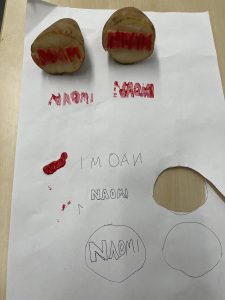

I began this activity by first watching the YouTube video provided. The task looked simple, but it was much more challenging than expected. I quickly realized that since I was carving out letters and not images, my letters had to be mirrored, complicating the task. Because I don’t regularly write words in reverse, I decided to make a template on paper and then trace the letters by poking holes with a pin into the potato. However, this method didn’t work as the holes were too small to see.
Furthermore, the size of my potato was smaller than I had hoped, making it hard to fit a five-letter word. The letters couldn’t be too small, or carving them would be too difficult and delicate, as the letters could break off. After cutting my potato in half, I realized that cutting it lengthwise would have provided more surface area negating my problem of fitting my word onto the potato.
After completing my first carving, I learned that the type of font also made a significant difference. My second carving was much easier after I decided to fit each letter into a square, which allowed me to space out the letters more evenly. The entire process, including planning and carving, took about an hour.
Making an exact replica was challenging on my first try. If I had bought more potatoes, I believe my carvings would have become more accurate with practice, allowing me to refine my technique. I decided to carve out “NAOMI,” my daughter’s name. The letters without curves (N, A, M, I) were much easier to carve, while letters needing a hollow middle (A, O) were more challenging.
After completing the task, I have a greater appreciation for the mechanization of writing because of its quickness and efficiency. Let’s just say I’m glad I don’t have to chisel this reflection onto a stone tablet.
